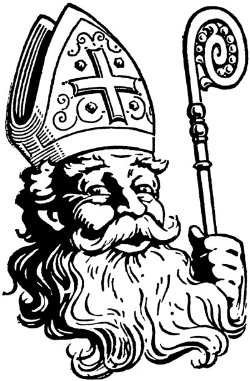 by Margaret Ehlen-Miller, Robert Miller, Loretta VanderVeen & Carol VanderVeen
by Margaret Ehlen-Miller, Robert Miller, Loretta VanderVeen & Carol VanderVeenYou've probably been curious more than once about where the idea of Santa Claus came from. Maybe you've wondered about his red outfit or why he was "chosen" to deliver gifts during Christmas night.
The story of Santa Claus began a long, long time ago. In the fourth century there lived a man named St. Nicholas, who was the bishop of Myra, Lycia. You will not be able to find the country of Myra, Lycia, on any map, because that ancient land is now part of Turkey. To be more exact, Lycia was located in southern Turkey in the region of the Taurus mountains.
St. Nicholas is one of the most popular of all the saints. He is the patron saint of Russia and the special protector of children. In England, there are hundreds of churches named after him.
 |
According to legend, in the community that St. Nicholas served, there lived a very poor man who could not afford to give a dowry of any kind for his three daughters. In fact he was so poor he could not afford to keep feeding them. So this unhappy man was at the point of turning his daughters out of his house where they surely would have come to no good. St. Nicholas secretly gave all three dowries so that these young girls could be saved from shame. This is said to have originated the custom of giving presents in secret on the eve of December 6, the day of St. Nicholas.
But Americans traditionally give gifts Christmas Eve, or on December 25! Ah yes, we are coming to that! As devotion to St. Nicholas spread, it eventually reached what is now Holland. At the time, Holland was a Spanish possession, and so St. Nicholas (in Dutch it's Sinter Klaas) acquired a certain Spanish air about him. He was pictured as a stately bishop complete with mitre and staff. He arrived by ship and rode a large white horse which could gallop over the roof tops as well as on land. And with him traveled a Moorish boy, Peter, dressed like a page with a ruff around his neck and a large feather in his beret. Peter carried switches for those who were bad and a pack of toys for those who were deserving.
Now we are starting to get a picture that shows a little resemblance to our Santa Claus. To this day in many countries St. Nicholas' eve is the time of gift giving, and Christmas remains a religious day, a quiet day for the family, but without the exchange of gifts.
But what of Santa Claus? . . . Americans adopted the custom and began to speak of Santa Claus'. But to them Santa Claus was not a stately bishop but "a right jolly old elf." He doesn't ride on a white horse with a servant in attendance but in a "miniature sleigh with eight tiny reindeer." Our image of "St. Nick" comes from a poem written in 1822 by Clement Clark Moore called "The Night Before Christmas." Moore wrote the story for his own six children and gave it to them as a gift. A family friend gave it to a newspaper; it was published, and was an immediate success. The story has remained with us, almost unchanged, since then. And so Santa has been transferred to December 25 and somewhat changed in appearance.
From The Gift of Time by Margaret Ehlen-Miller, Robert Miller, Loretta VanderVeen & Carol VanderVeen. Copyright © 1977 Morehouse Publishing, Harrisburg, Pennsylvania. Used by permission.
3 comments:
fabulous post!
I enjoyed reading this!
Great post, I enjoyed reading this as well.
Post a Comment